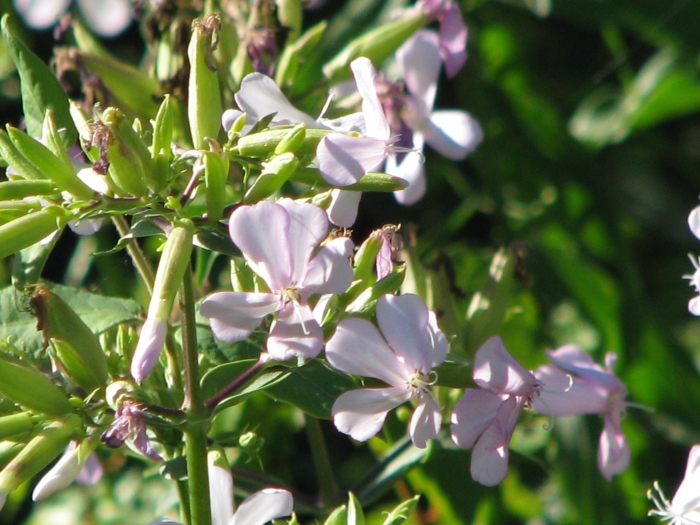Common Soapwort
(Saponaria officinalis)
Common Soapwort (Saponaria officinalis)
/
/

DM
CC BY 4.0
Image By:
DM
Recorded By:
Copyright:
CC BY 4.0
Copyright Notice:
Photo by: DM | License Type: CC BY 4.0 | License URL: http://creativecommons.org/licenses/by/4.0/ | Rights Holder: DM | Publisher: iNaturalist | Date Created: 2018-08-01T21:51:32Z |
























Estimated Native Range
Summary
Saponaria officinalis, commonly known as common soapwort, is a perennial herb that is native to a wide range of habitats in Europe and western Asia, including open woodlands, grasslands, and along riverbanks. It is often found in disturbed areas such as hedgerows and roadsides. This plant typically grows up to 28 inches tall and has a clumping form with broad, lanceolate leaves. From May to September, it produces clusters of sweetly scented pink or white flowers that are highly attractive to pollinators.
Common soapwort is valued for its long flowering season and the sweet fragrance of its blooms. It is used in informal garden settings, cottage gardens, and as a ground cover. Soapwort thrives in full sun to part shade and prefers well-drained soil, though it is tolerant of a variety of soil conditions. It requires moderate water and can be drought-tolerant once established. Gardeners should be aware that soapwort can spread aggressively by rhizomes and self-seeding, potentially becoming invasive. It is also known for its historical use as a gentle cleaning agent, as the leaves and roots contain saponins that create a lather when mixed with water.CC BY-SA 4.0
Common soapwort is valued for its long flowering season and the sweet fragrance of its blooms. It is used in informal garden settings, cottage gardens, and as a ground cover. Soapwort thrives in full sun to part shade and prefers well-drained soil, though it is tolerant of a variety of soil conditions. It requires moderate water and can be drought-tolerant once established. Gardeners should be aware that soapwort can spread aggressively by rhizomes and self-seeding, potentially becoming invasive. It is also known for its historical use as a gentle cleaning agent, as the leaves and roots contain saponins that create a lather when mixed with water.CC BY-SA 4.0
Plant Description
- Plant Type: Herb
- Height: 1-3 feet
- Width: 1-2 feet
- Growth Rate: Moderate, Rapid
- Flower Color: Pink, White
- Flowering Season: Spring, Summer, Fall
- Leaf Retention: Deciduous
Growth Requirements
- Sun: Full Sun, Part Shade
- Water: Medium
- Drainage: Fast, Medium
Common Uses
Border Plant, Fragrant, Groundcover, Low Maintenance
Natural Habitat
Native to open woodlands, grasslands, and along riverbanks in Europe and western Asia
Other Names
Common Names: Soapwort, Sweet William, Bouncingbet Soapweed, Common Soapwort, Latherwort
Scientific Names: , Saponaria officinalis, Bootia saponaria, Bootia vulgaris, Lychnis officinalis, Lychnis saponaria, Sabulina hybrida, Saponaria alluvionalis, Saponaria hybrida, Saponaria nervosa
GBIF Accepted Name: